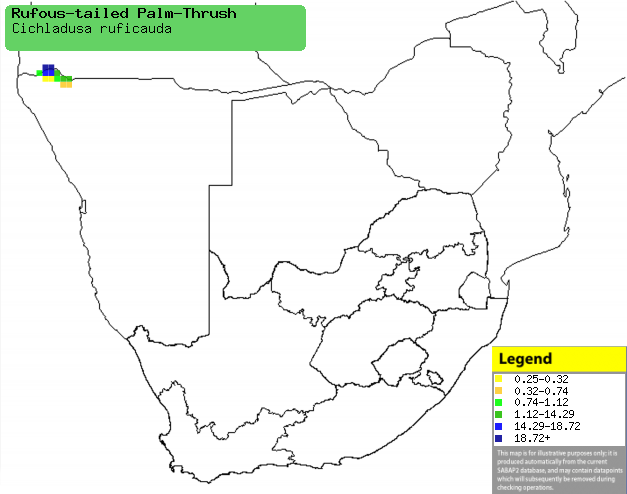|
Cichladusa ruficauda (Rufous-tailed
palm-thrush)
Rooistertmôrelyster [Afrikaans]; Gabon-palmlijster [Dutch];
Cichladuse à queue rousse [French]; Graubruströtel [German];
Tordo-das-palmeiras-de-cauda-vermelha [Portuguese]
Life
> Eukaryotes >
Opisthokonta
> Metazoa (animals) >
Bilateria >
Deuterostomia > Chordata >
Craniata > Vertebrata (vertebrates) > Gnathostomata (jawed
vertebrates) > Teleostomi (teleost fish) > Osteichthyes (bony fish) > Class:
Sarcopterygii (lobe-finned
fish) > Stegocephalia (terrestrial
vertebrates) > Tetrapoda
(four-legged vertebrates) > Reptiliomorpha > Amniota >
Reptilia (reptiles) >
Romeriida > Diapsida > Archosauromorpha > Archosauria >
Dinosauria
(dinosaurs) > Saurischia > Theropoda (bipedal predatory dinosaurs) >
Coelurosauria > Maniraptora > Aves
(birds) >
Order: Passeriformes > Family: Muscicapidae
> Genus: Cichladusa
Distribution and habitat
Occurs in a band from Gabon, Congo and eastern DRC to
Angola and the extreme north-western region of Namibia. Here it is locally
common in gallery forests and riverine woodland, especially with interspersed
Northern lala palms (Hyphaene petersiana).
|
 |
|
Distribution of Rufous-tailed palm-thrush in southern Africa,
based on statistical smoothing of the records from first SA Bird Atlas
Project (©
Animal Demography unit, University of
Cape Town; smoothing by Birgit Erni and Francesca Little). Colours range
from dark blue (most common) through to yellow (least common). |
Food
It mainly eats invertebrates, such as beetles (Coleoptera)
and
spiders, doing most of its foraging on the ground but also gleaning food
from leaves and branches. It additionally eats the fruit of the Oil palm (Elaeis
guineensis).
Breeding
- The nest is a deep, well-rounded cup made of mud and plant fibres and
lined with finer plant material. Both sexes construct it, carrying material
along the same route, repeatedly calling from perches along the way. It is
typically attached to a vertically hanging palm frond or at the point at
which it connects to the trunk, but it may also be placed in a cavity in the
trunk of a Baobab (Adansonia digitata) or some other forest tree, on
a rock or brick ledge, window-sill or under the eaves of a building.
- Egg-laying season is from about November-April in Namibia.
- It lays 2-4 greenish white eggs, which are speckled with rufous.
- Both adults feed the chicks; on the way to and fro from the nest they
stop of at staging posts to sing, like they do when they first build the
structure.
Threats
Not threatened globally, although there is a plan to
implement hydro-electric schemes in the Cunene River flood plain, Namibia, which
could drive its population in the country to near-extinction.
References
-
Hockey PAR, Dean WRJ and Ryan PG 2005. Roberts
- Birds of southern Africa, VIIth ed. The Trustees of the John Voelcker
Bird Book Fund, Cape Town.
|
